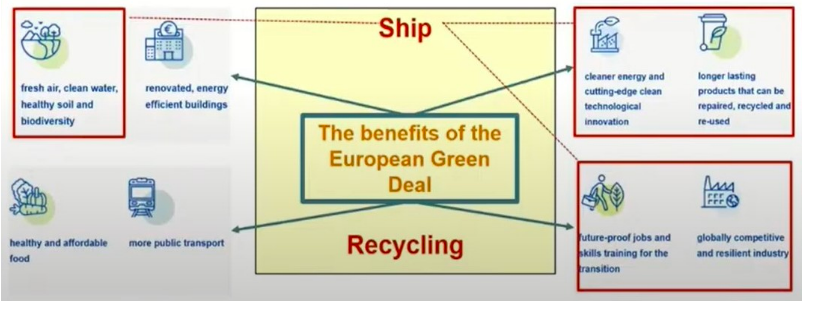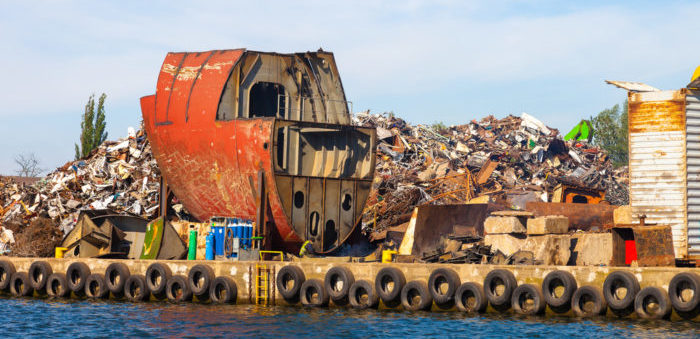During the latest GREEN4SEA Virtual Forum, Dr. Konstantinos Galanis, Chairman of the International Ship Recycling Association, discussed about the European Union Taxonomy and its relationship to the ship recycling, highlighting the fact that the economic activity needs to meet and qualify as an environmentally sustainable solution.
On top of achieving our goals with respect to ship recycling, it is critical that we have first and foremost ensured the safety of the workers and the environmental protection, he stressed.
What is the EU Taxonomy?
EU Taxonomy is a classification system establishing a list of environmentally sustainable economic activities that are assisting the EU to scale up the sustainable investment and implementation of the European Green Deal.
What is the European Green Deal?
The transformation of the EU into a modern resource-efficient and competitive economy, ensuring:
- no net emissions of greenhouse gases by 2050;
- economic growth decoupled from resource use, and
- no person and no place left behind.
Ship recycling can assist in minimize the environmental footprint of the vessels, if it is implemented in the proper way, based on the ship recycling directions and requirements”
Dr. Konstantinos Galanis talked about the economic growth that has to be decoupled from the resource use, saying that “this is one of the most important supporting additions of the ship recycling to the ship life where we can minimize the resource use by several means.”
The European union taxonomy provides to the companies, investors, and policy makers with the appropriate definitions for which economic activities can be considered environmentally sustainable. Environmental sustainability is one of the main parameters that most – if not all – the transformation means are heading to.
As he explained, it is important to define, allocate, explain, and implement ship recycling the proper manner to ensure that it will assists the European Commission and the international framework to head in the future. What is more, it will help companies to become more client-friendly, mitigate market fragmentation and help shift investments where there are most needed.
Why we need the EU taxonomy?
EU’s climate and energy targets for 2030 are mainly focused on investments that have to be directed towards sustainable projects and activities to make our economies, business, and societies more resilient against climate environmental shocks.
As Dr. Konstantinos Galanis noted, European Green Deal promotes fresh air, clean water, healthy soil, and biodiversity, where ship recycling plays a significant role.
In addition, it is important to focus on the cleaner energy and cutting-edge technological innovations. This is where we should emphasize regarding ship, in order to make sure that the emissions overall produced by the shipping business can be further minimized by following the proper ship recycling practices.

To remind, the taxonomy regulation and the delegated acts are in force since the 12th of July 2020. And the basis has been established for the EU taxonomy by setting out four overarching conditions in order to the economy activity to meet and qualify as an environmentally sustainable option.
The 4 conditions are:
- Must substantially contribute to one or more of the environmental objectives;
- do no significant harm (DNSH) to any of the other environmental objectives;
- be carried out in compliance with minimum social and governance safeguards and
- comply with technical screening criteria, which the climate delegated act sets out in relation to climate change mitigation and climate change adaption.
The taxonomy regulation establishes 6 environmental objectives:
- Climate change mitigation
- Climate change adaptation
- The sustainable use and protection of water and marine resources
- The transition to a circular economy
- Pollution prevention and control
- The protection and restoration of biodiversity and ecosystems
Ship recycling is heading to this direction and is one of the main parameters the shipping companies should take into account.
Furthermore, in order to be able from the ship recycling perspective to ensure that the value in this way going forward of the EU taxonomy will be satisfied, we need to be able to have that applicability of the regulations being present in this matrix within the ship recycling framework.

[Note: The EU Ship Recycling Regulation (EU SRR) / EU Waste Shipment Regulation (EU WSR) ]
“The ship owners, the shipping companies and all the people within the shipping industry have to understand that we need our human resources, and we need to protect our environment.”
In order for a vessel to meet this target in this regard, it is critical to design, operate and recycle the vessels properly, to have a complete set of operations and compliance to proceed in the future regarding all these interesting developments that have been set by the European Union.
Explore more by watching the video below:
Above article is a transcript text of Dr. Galanis presentation during 2022 GREEN4SEA Forum.
The views presented are only those of the author and do not necessarily reflect those of SAFETY4SEA and are for information sharing and discussion purposes only.

































































